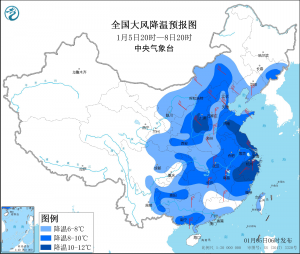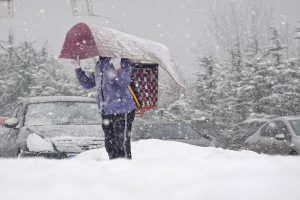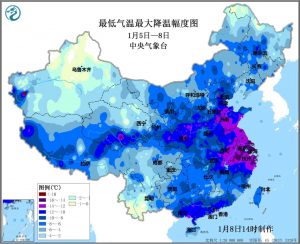Another Cold Surge Sweeping Across China

Formation
In mid-December, after a country-wide cold wave, the NCEP-Global Forecast System (GFS) became increasingly aggressive towards the formation of an equator facing trough off of the polar vortex in Siberia. The forecast called for the trough moving southwest and turning poleward, creating a massive cooldown across China right after the new year. Soon after, in late December, global models (including the ECMWF-HRES and NCEP-GFS) formed a consensus towards a massive cold wave sweeping across the major part of China from January 6-11, causing unprecedented low temperatures in multiple major cities. Several meteorology enthusiasts and experts questioned the forecast due to its extreme magnitude. However, the consensus on the cold wave remained.

Impacts-Beijing
The cold wave would heavily impact Beijing, with many stations breaking the record for the lowest temperature ever recorded. Beijing’s baseline station, WMO station number 54511 (also known as Nanjiao officially) recorded the lowest temperature of -19.6°C at 6:40 on the morning of January 8th. This is the lowest temperature recorded since 54511’s establishment in 1912, breaking the previous record set in 1972 by -1.3°C.
The last instance of a cold wave of this magnitude occurred on February 22, 1966, where the city of Daxing recorded a temperature of -27.4°C directly after the passing of a cold front and snow. However, this record is controversial, as other stations in the city only recorded temperatures of -18°C to -20°C. Assuming that reading was incorrect, the temperatures caused by this cold wave would be at least the coldest temperature in Beijing for over a century before.
Shanghai
Surprisingly, the cold wave heavily impacted Shanghai as well. More often than not, the warm sea surface temperatures of the Yellow Sea prevent Shanghai from cooling as much as cities further inland. During this massive cold wave, the baseline stations of Shanghai (Baoshan and Xujiahui) saw three continuous days of temperatures below 0°C, with the coolest temperature of -7.3°C recorded, and coolest daytime temperature of -4.3°C recorded at Baoshan.
Guangzhou and Hong Kong
The Guangzhou urban area recorded sleet on the morning of January 11th, making Guangzhou the southernmost city to receive solid precipitation. A sounding revealed that the temperature between Geopotential Height of 800-900mb (approximately 800-2000m above sea level) was just below 0°C, allowing the raindrops forming higher to freeze when passing this layer, causing sleet.
In Hong Kong, precipitation wasn’t as widespread during this cold wave nor did temperatures go as low compared to large cold waves. However, Hong Kong did receive impacts. Tai Mo Shan station recorded a temperature of -2.5°C during the cold wave on January 9th. The temperature was warmer in urban areas because of warm sea surface temperatures releasing heat into the atmosphere. At HKO headquarters, the lowest temperature recorded was 7.7°C, failing to break the record of 3.1°C set by the cold wave in January 2016 that broke several temperature records across southern China. This was largely due to the precipitation before the cold front passed, which was not present when this cold wave passed Hong Kong.
Other Parts of China
Most cold waves associated with large precipitation mainly impact southern China. However, this unusually strong cold wave focused on the northern part of China. Temperatures in Shandong broke records that stood since 1949, and lake effect snow impacted the coast of Bohai Bay.

Aftermath
The cold wave one of the most powerful to occur this century, heavily impacting northern China with low temperatures. Beijing broke its all-time highest power consumption record set in Summer 2018 due to the extreme cold, reaching over 2,400 Megawatts. The freezing temperatures also damaged agriculture in Jiangsu and Shanghai, especially fruits. Although most of the damages are relatively unclear as of this time, this cold wave is likely one of the costliest cold waves in Chinese history.

